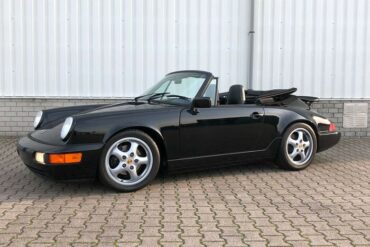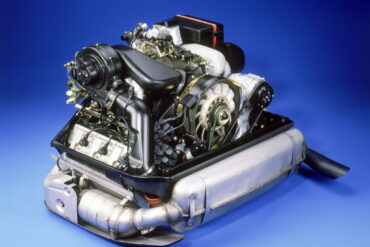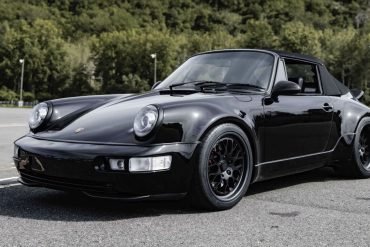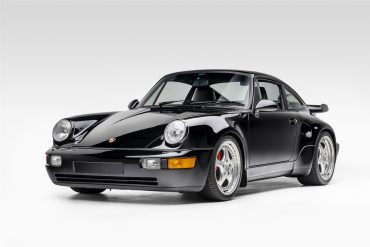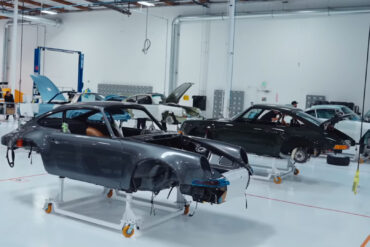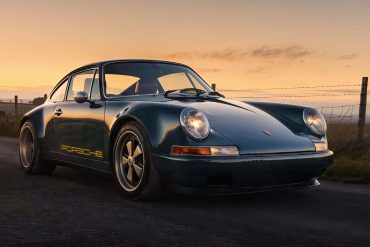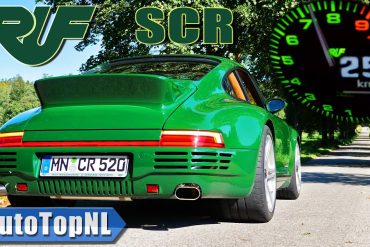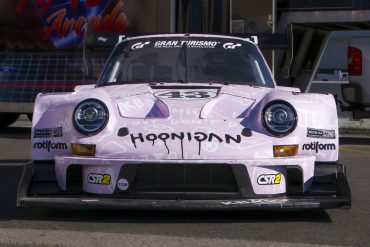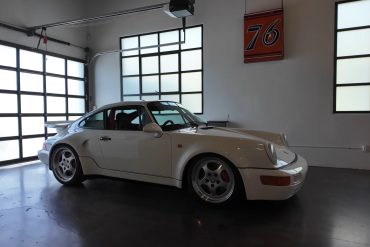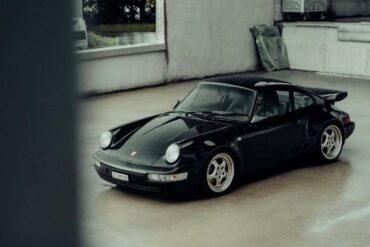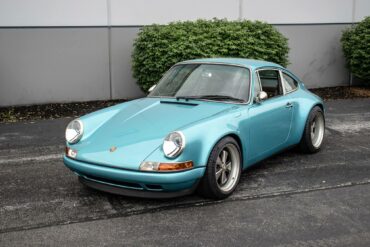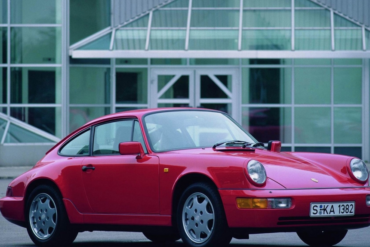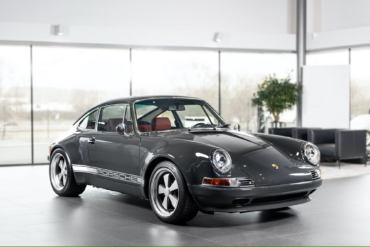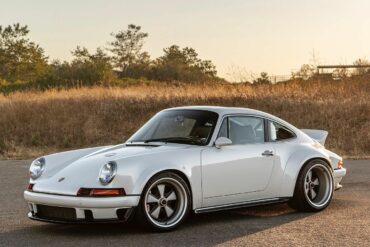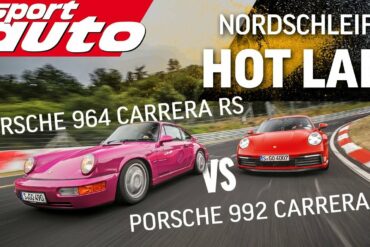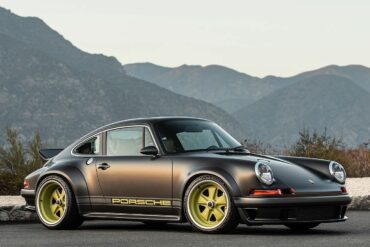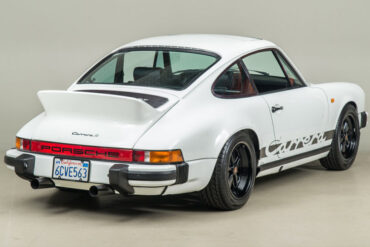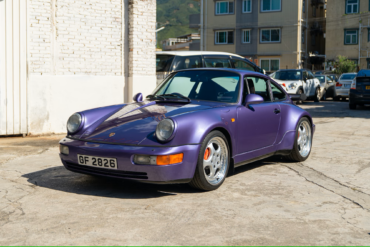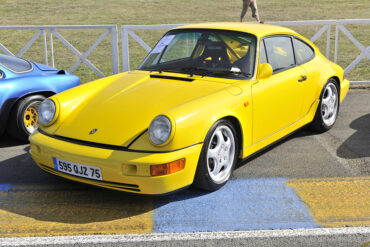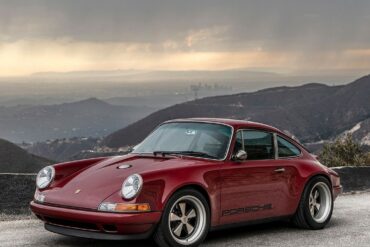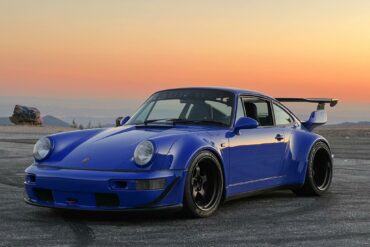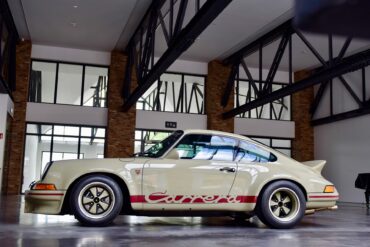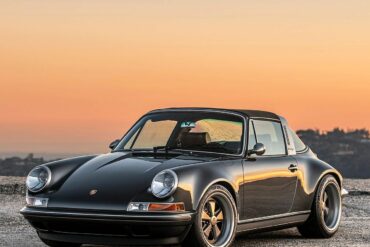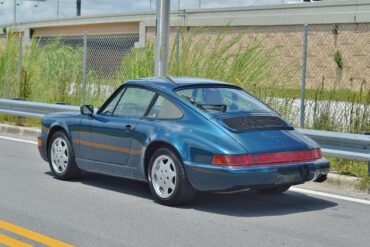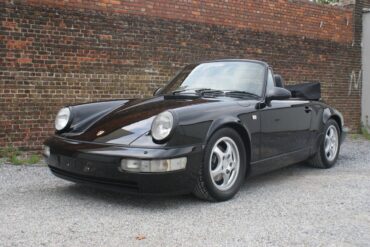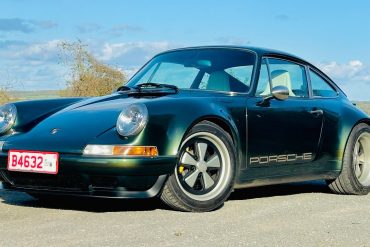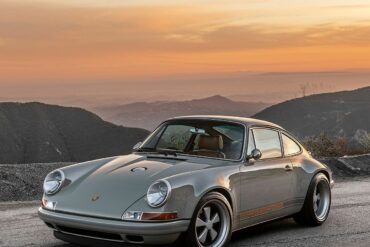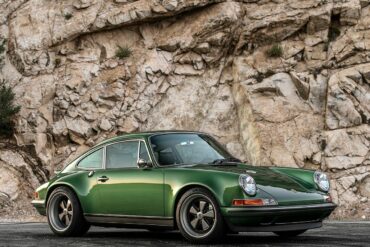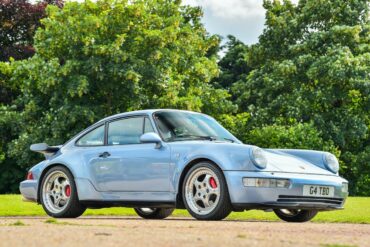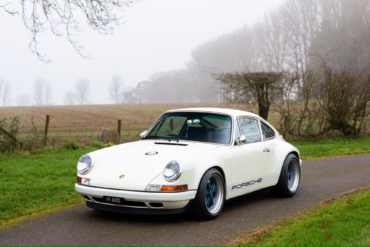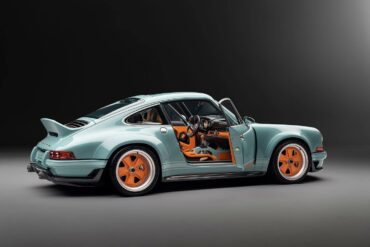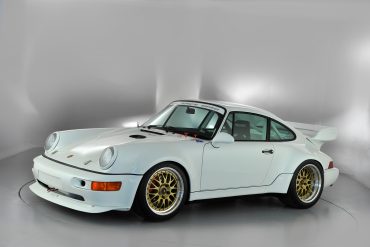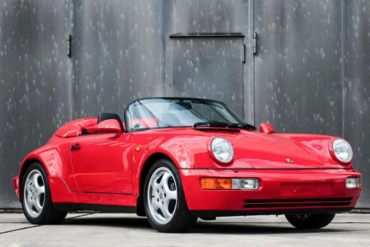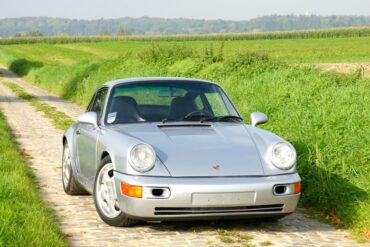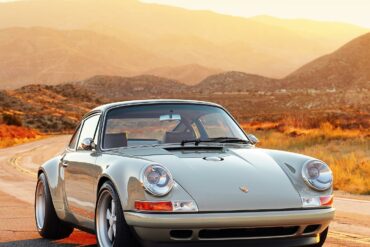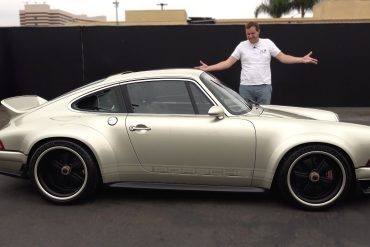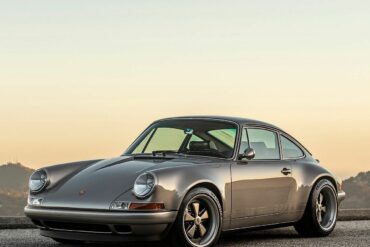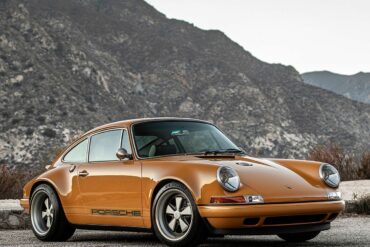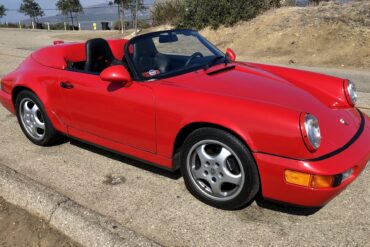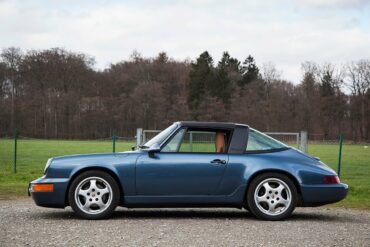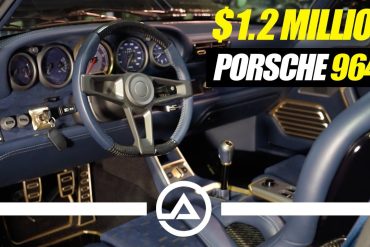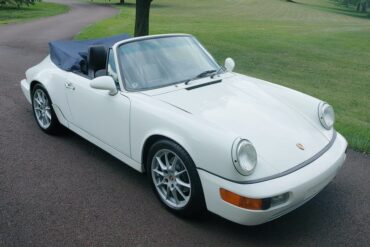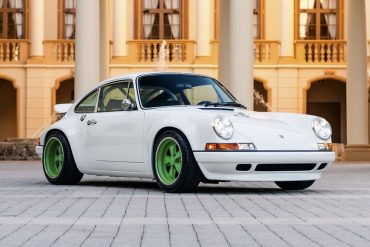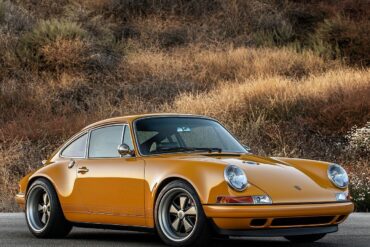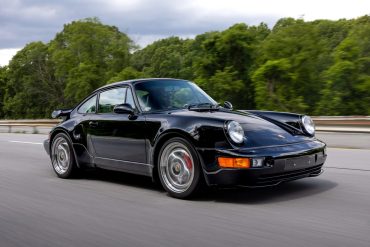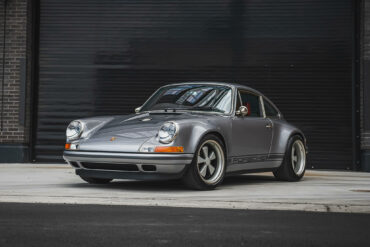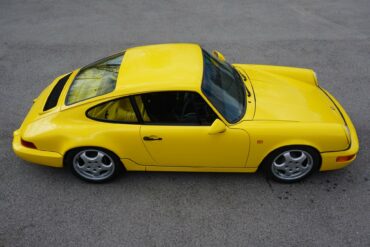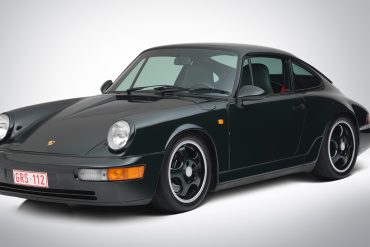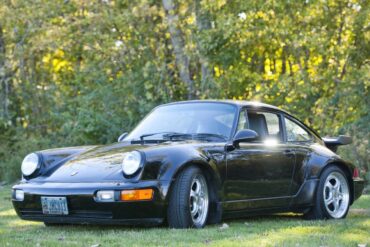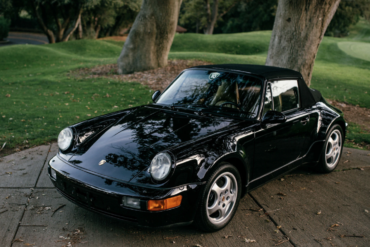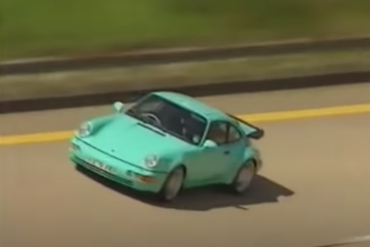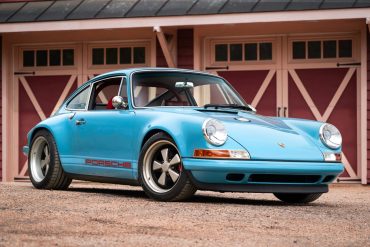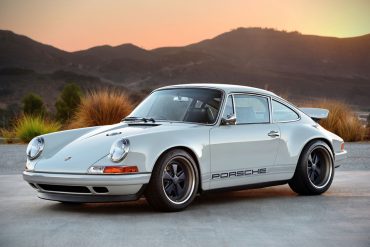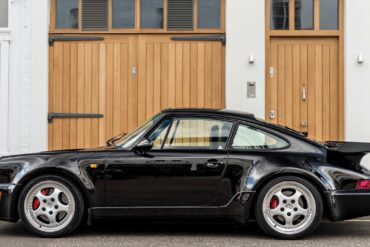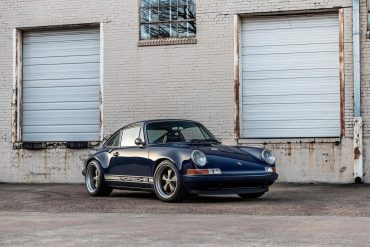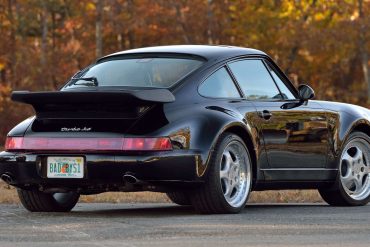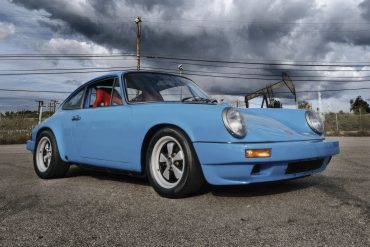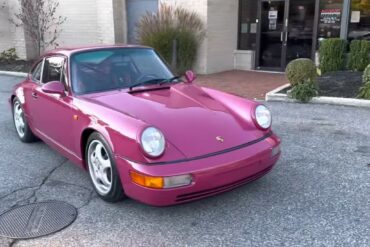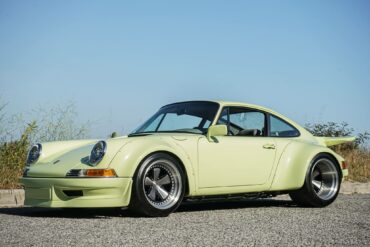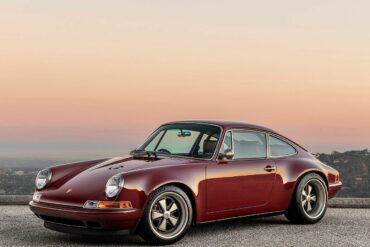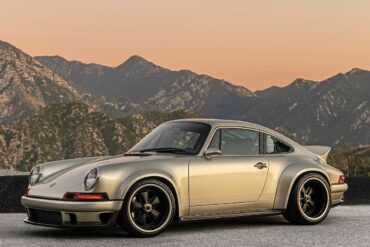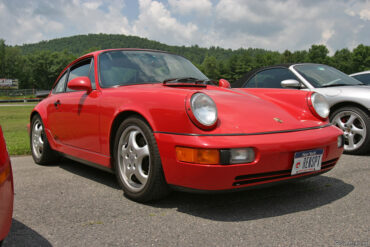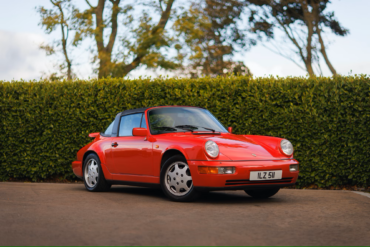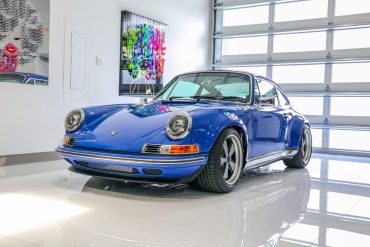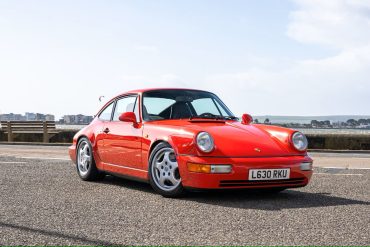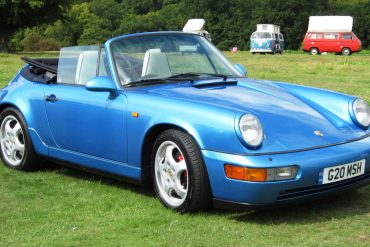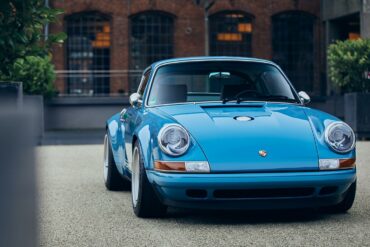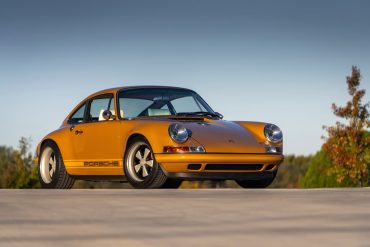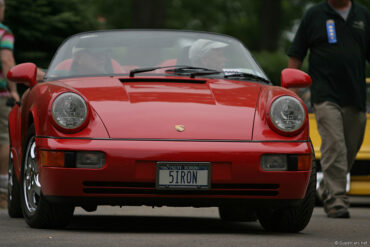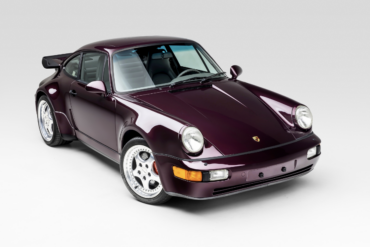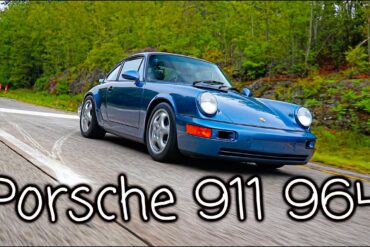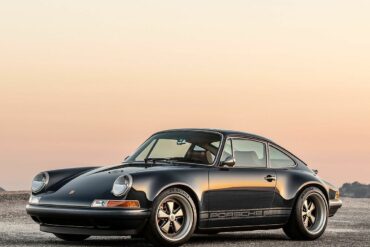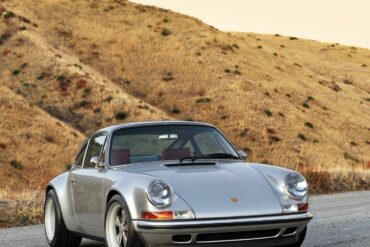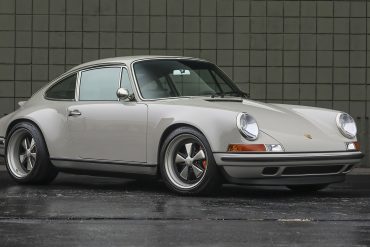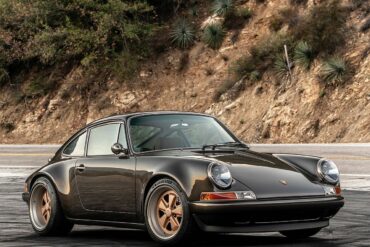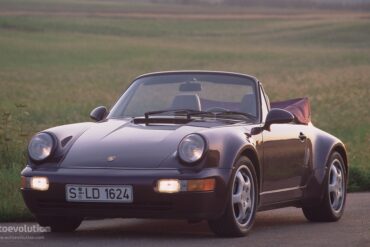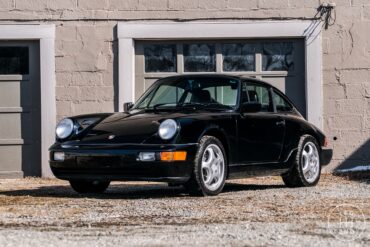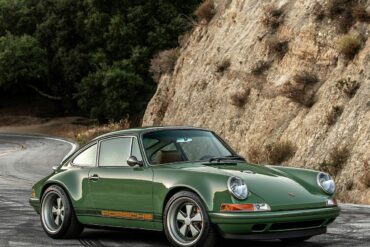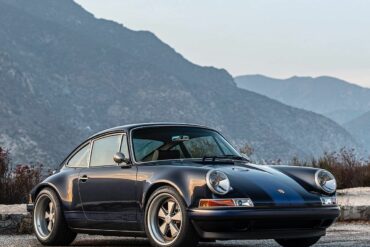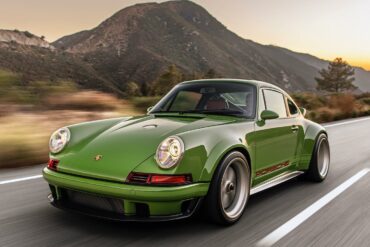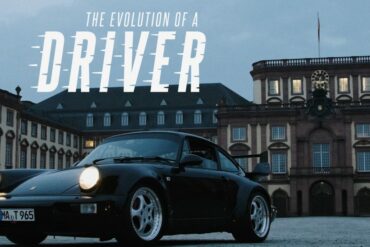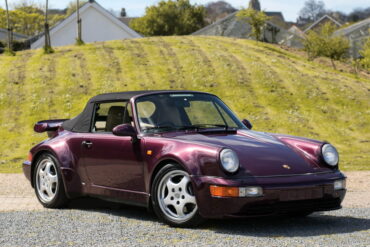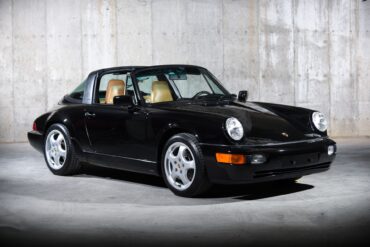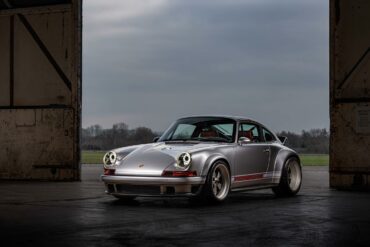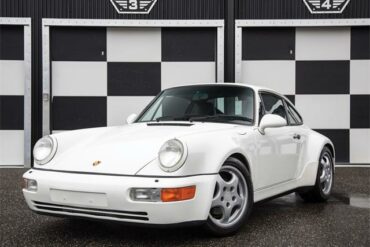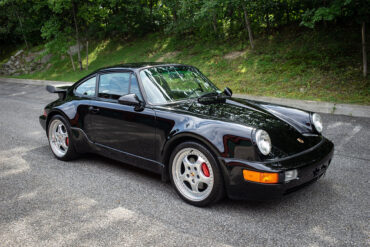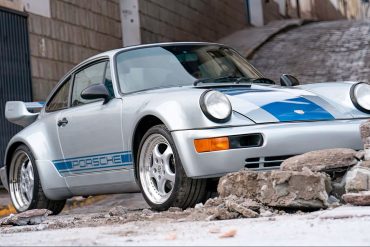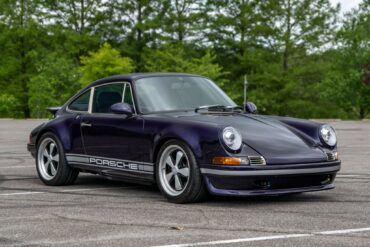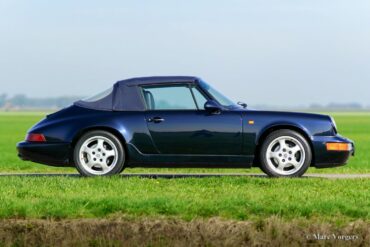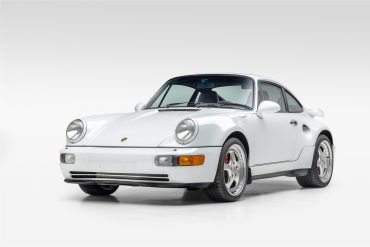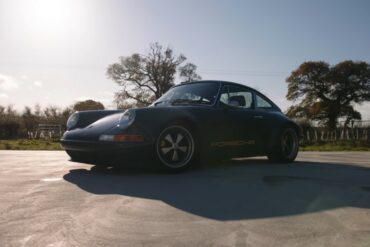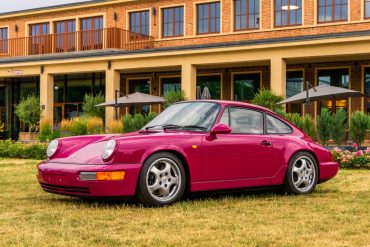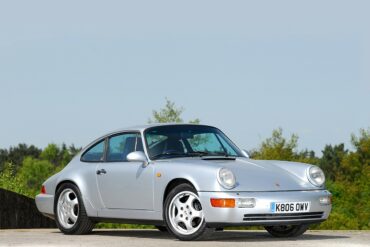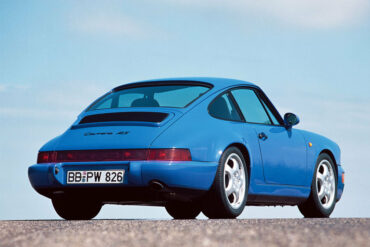1990 Porsche 911 Carrera 4 Cabriolet (964) Technical Specifications Engine Type Flat 6 Induction Normally-aspirated Cooling Air/oil-cooled Valvetrain Single overhead...
Porsche 911 (964)
In 1989 Porsche came out with the 911 Carrera 4 (964). The new 911 was a contemporary take on the classic two-door sports car and came at a time when many were predicting the end of the 911 (the company was producing the 944 and working on the upcoming 968). The long run of the previous 911 meant the 964 needed a major update and Porsche delivered on that promise with 85% new components and virtually none of the predecessor’s architecture used. Save for the introduction of aerodynamic polyurethane bumpers and an automatically-extending rear spoiler which replaced the “whale tail” found on the 911 throughout the 1980’s, externally, the 964 kept the same style as the classic 911. The 964 rode on a completely redesigned chassis with rear suspension switching from torsion bar to trailing arms with Porsche’s “Weissach” rear axle, which added self-steering elements to reduce the chance of oversteer. It featured a naturally aspirated 3.6 liter boxer engine that produced an impressive 250 horsepower. See all of our Porsche 964 Research.
Porsche 911 (964) Engine Codes The engine number is located on the engine block, on the right side of the...
While I admit the title is misleading, American company Sacrilege Motors does have the answer to the question; “Both.” That’s...
In 1994, the standard Porsche Turbo 3.6 was the fastest production car available in the United States. The Turbo S...
Singer has come a long way since its founder Rob Dickinson started turning Porsche 964s into four-wheeled jewelry 12 years...
The esteemed UK firm, Theon Design, known for their custom reconfigurations of the iconic Porsche 911, has recently unveiled a...
In this video from AutoTopNL, we get to see and hear a RUF SCR 4.0 being pushed to its limits...
If you think post-war sports cars or muscle cars from the late 1960s are the staple of the collector car...
In Magnus Walker’s newest video on YouTube, we get a closer look at an ultra-rare 1993 Porsche 964 Turbo S...
The 1989/90 change of model year saw the launch of the Porsche 911, 964 series onto the market. This 911...
The Sundown Commission is a stunning example of Singer’s craftsmanship and attention to detail. It features a beautiful Horizon Blue...
Porsche added the rear wheel drive Carrera 2 variant to the range in 1990. It was developed alongside the 964 Carrera 4, Porsche waited a year to release the Carrera 2 as a 1990 model year car. Like the Carrera 4, the Carrera 2 was available as a coupé, Targa or Cabriolet. Overall, the Carrera 2 packed almost the same technical specifications as the Carrera 4 model. The engine was the same 3.6 liter unit which produced 250 horsepower and a maximum speed of 162 mph. Looked like C4 but was 200 lb lighter and more fun to drive.
This ‘Sooner’ 911 is based on a 1990 964 Carrera 2 and has undergone significant modifications to both its appearance...
Named “Thing 1” by its owner, this car showcases a Parallax White exterior with a Black interior. Utilizing Computational Fluid...
Nordschleife Hot Lap In A Porsche 964 RS vs. 992 Carrera S Porsche 911 Carrera RS (964), Porsche 911 Carrera...
Singer Vehicle Design – Naples Commission Today, we take a closer look at the Singer Vehicle Designs Naples Commission. This...
1965 – 1989 Porsche VIN Numbers Porsche used a variety of chassis and VIN numbering systems until 1981, when a...
In 1992, Porsche unveiled a limited-edition masterpiece – the 964 Turbo S Lightweight, also known as the Leichtbau. Originally planned...
At the Geneva Motor Show in March 1992, the 3.3-litre 964 Turbo S was unveiled sporting air inlet vents in...
Singer Vehicle Design – Westlake Commission Today, we take a closer look at the Singer Vehicle Designs Westlake Commission. The...
Strap in as Christian Gebhardt from sport auto pushes a Porsche 911 (964) Carrera RS to its limits around the...
For race teams and track day customers Porsche prepared a small number of the 964 Cup cars according to the FIA NG-T regulations. Officially called the Competition model, these custom-ordered cars were an intermediary step between the Carrera Cup option (M001) and the standard tourer (M002). This M0003 option was available directly from Porsche as a road-going model. These cars had almost all the Carrera Cup modifications including the new suspension. This lowered the car by 40mm in the rear and 50mm in the front. It also included fitting of the larger 930 Turbo disc brakes and adjustable anti-roll bars.
Singer Vehicle Design – Berlin Commission Today, we take a closer look at the Singer Vehicle Designs Berlin Commission. This...
This one-of-a-kind RWB build boasts custom hand-fitted bodywork, including modified bumpers, rocker panels, bolt-on fenders, a GT2-style rear wing, a...
DP Motorsport’s 964 RSR Recreation – “Stonegrey” Here’s another gem from the folks at DP Motorsport, this time with the...
Singer Vehicle Design – Hidden Hills Commission Today, we take a closer look at the Singer Vehicle Designs Hidden Hills...
1993 Porsche 911 Carrera 2 Coupe (964) Technical Specifications Engine Type Flat 6 Induction Normally-aspirated Cooling Air/oil-cooled Valvetrain Single overhead...
Founded in Los Angeles in 2009, Singer is globally renowned for bespoke restorations of Porsche 911 sports cars. Based on...
The Carrera 4 model also launched with a Cabriolet version in 1989 (for 1990 model year). The new 911 generation is introduced in Autumn 1988, but the convertible was not launched until the model year 1990. Alterations to the body include the bumpers and sill tread plates, and the 911 continues to be equipped with an automatically retractable rear spoiler and a cowled underbody. The braking system is fitted with ABS. The 911 (Type 964) also features power-assisted steering for the first time. Like the Coupe, the Cabriolet got the new all-wheel drive system.
In one of the latest videos from Harry’s Garage on YouTube, we get treated to a closer look at the...
Singer Vehicle Design – Queenstown Commission Today, we take a closer look at the Singer Vehicle Designs Queenstown Commission. The Queenstown...
Vintage Porsche 911s have garnered immense popularity in the restoration world, giving rise to businesses entirely dedicated to their reconstruction....
Singer Vehicle Design – Copenhagen Commission Today, we take a closer look at the Singer Vehicle Designs Copenhagen Commission. This...
Porsche 911 (964) Paint Color Options This post outlines all the color options for the 964 generation Porsche 911 over...
Dubbed “Newcastle Commission,” the car is based on a 964 Carrera 2. This 911 Reimagined by Singer also features the...
Singer Vehicle Design – Milano Commission Today, we take a closer look at the Singer Vehicle Designs Milano Commission. First...
Every so often, Porsche creates a short production run of cars that celebrates the attributes of one of their special...
In contrast to the 911 Speedster from the 1989 model year, the 964 Speedster was only offered and produced with the narrow body shape. In December 1991, the first wide bodied prototype based on a 964 Carrera 2 Convertible Turbo-Look was registered at Porsche AG, but it never made it ready for a series production. In response to recurring customer requests for Turbo-Look Speedsters - the optical characteristics of the wide body in combination with the flat windscreen and fiberglass cover had found many fans - Porsche converted the previously individually ordered, narrow Speedster in the exclusive department.
Phil Wagenheim is a successful New York investor who also serves as CEO at Sacrilege Motors in Connecticut. During the...
The 964 Carrera RS (Standard) was introduced by Porsche for model year 1992 specifically for the European market as a lightweight, high performance version of the 964 Carrera 2. It featured a revised version of the standard 3.6 liter engine, titled M64/03 internally, with an increased power output of 260 bhp (194 kW; 264 PS). The RS does not look much different from the other 911 models of the period but its weight is reduced and power increased. True to its racing spirit, the Carrera RS featured bucket seats and thinner materials, but lacked power windows, air conditioning, air bags, and other creature comforts.
Singer Vehicle Design – New York Commission Today, we take a closer look at the Singer Vehicle Designs New York...
Touted by Singer as the ‘most advanced air-cooled 911 in the world’, the Singer DLS has a custom-bored 4.0L flat-six...
Singer Vehicle Design – Canyon Drive Commission Today, we take a closer look at the Singer Vehicle Designs Canyon Drive...
Singer Vehicle Design – Hollywood Commission Today, we take a closer look at the Singer Vehicle Designs Hollywood Commission. Like...
Note: Some images from this article provided by Roger Katz. The Type 964 Porsche 911 was a revolutionary car when...
1990 Porsche 911 Carrera 4 Targa (964) Technical Specifications Engine Type Flat 6 Induction Normally-aspirated Cooling Air/oil-cooled Valvetrain Single overhead...
Porsches have consistently attracted tuners and racing teams aiming to enhance the performance of already formidable sports cars. The 356...
1991 Porsche 911 Carrera 2 Cabriolet (964) Technical Specifications Engine Type Flat 6 Induction Normally-aspirated Cooling Air/oil-cooled Valvetrain Single overhead...
Background Perhaps no company has celebrated the heritage of the air-cooled 911 with such obsessive attention to detail as California-based...
Singer Vehicle Design – Raffles Commission Today, we take a closer look at the Singer Vehicle Designs Raffles Commission. The...
This 1994 Porsche 911 Turbo S 3.6 Package is a stunning example of one of the 17 “Package” models produced...
Singer Vehicle Design built the “Greenwich Commission” between 2017 and 2019 as their 109th project. This customized 911 is based...
1991 Porsche 911 Carrera 4 Lightweight (964) Technical Specifications Engine Type Flat 6 (M64/03 Flat-6) Induction Naturally Aspirated Cooling Air/oil-cooled...
Porsche introduced the 964 Carrera RS for the 1992 model year, specifically targeting the European market as a lightweight, high-performance...
1992 Porsche 911 Turbo 3.3 Coupe (964) Technical Specifications Engine Type Flat 6 Induction Turbocharged Cooling Air/oil-cooled Valvetrain Single overhead...
The American Roadster is essentially a turbo-bodied Carrera Cabriolet with Turbo suspension and brakes. Like the 356 America Roadster it was named after, the Type 964 America Roadster was a limited-edition, driver-focused convertible destined for the American market. Production for the America Roadster was limited at only 250 examples, and the model was only produced in 1992 and 1993. Its engine was a standard unit making 250 horsepower, but the special edition had the wide fender flares, suspension, brakes, and 17-inch Porsche Cup wheels of the 911 Turbo.
964 911 Turbo Review Tiff is my favorite presenter.. You looks like a silly unassuming British man, then he gets...
Rob Dickinson, founder of Singer Vehicle Design, has transformed his childhood obsession with Porsche 911s into a company crafting automotive...
Singer Vehicle Design has entered into a historic agreement with Porsche Motorsport North America. It is a partnership that will...
1993 Porsche 911 Turbo 3.6 Coupe (964) Technical Specifications Engine Type Flat 6 Induction Turbocharged Cooling Air/oil-cooled Valvetrain Single overhead...
Singer Vehicle Design, founded in 2009 by former Catherine Wheel frontman Rob Dickinson and based in Los Angeles, specializes in...
Porsches are, by nature, expensive cars. Still, it’s hard not to notice when one sells for over a million dollars,...
While originating from the East Coast, 5001 Workshop founder Marlon Goldberg gravitates towards building Porsches for their experience, not their...
Autosport Designs takes the Porsche 911/964 RS N/GT Clubsport for a test drive. One of only 290 examples produced and...
This 1991 Porsche 964 Carrera 4 is an exceptional, one-of-a-kind build that was commissioned to RWBLA, a team of experts...
Singer Vehicle Design – Kensington Commission Today, we take a closer look at the Singer Vehicle Designs Kensington Commission. First...
Singer Vehicle Design – Caroline Commission Today, we take a closer look at the Singer Vehicle Designs Caroline Commission. First...
The original 1973 Carrera RS was available in Europe but not in the USA. Porsche decided to build the 1993 Carrera RS both to European spec and a limited number in compliance with US regulations. These US spec cars were assigned the name “RS America”. The intent was to create a basic lightweight, no frills 911 with minimal luxury options. The standard US Carrera 2 brakes, engine and gearbox were used. The RS weighed 2,945 pounds so it was almost 80 pounds lighter than a standard Carrera 2.
Collecting Cars is auctioning a stunning example of the 964-generation Porsche 911 Carrera 2 Targa. This particular example is offered...
Starting with a European-market 964 Carrera 4 that retains its original numbers, this 1991 model underwent an extensive custom nut-and-bolt...
In tribute to the iconic 1973 911 Carrera RS, Porsche applied a similar strategy to craft a lightweight version of...
1990 Porsche 911 Carrera 2 Cabriolet (964) Technical Specifications Engine Type Flat 6 Induction Normally-aspirated Cooling Air/oil-cooled Valvetrain Single overhead...
Singer Vehicle Design – Wiesbaden Commission Today, we take a closer look at the Singer Vehicle Designs Wiesbaden Commission. The...
This Saturday, Mecum Auctions will be offering a beautiful 1990 Porsche 911 Carrera 2 Coupe that has been reimagined by...
The 964 based Speedster was the 1994 Speedster which was based on the 964 Carrera 2 platform. There are far fewer 1994 911 Speedsters in the world than the 1989 model, with production reportedly totaled only around 936 units, less than half as many as the 1989 example. Whereas the 1989 Speedster was primarily an aesthetic package, the 964 version sought a happy medium between the regular Carrera 2 and the hardcore Carrera RS. It had the same engine as the base Carrera and didn’t have the same suspension bits as the RS.
An Eye-Catching Amethyst Metallic 964 Porsche 911 Turbo Fetches Big Money At Auction How about $401,000 for a 1994 Porsche 911...
Behind the Wheel of a 964 Carrera 2 Quick review of this beautiful 1990 Porsche 911 964 Carrera 2 manual...
Singer Vehicle Design – Newport Commission Today, we take a closer look at the Singer Vehicle Designs Newport Commission. This...
Singer Vehicle Design – Mexico Commission Today, we take a closer look at the Singer Vehicle Designs Mexico Commission. At...
“A Relentless Pursuit of Excellence.” This philosophy guides Singer’s work and epitomizes the quality of their artistry, which is evident...
The “Indy Commission” by Singer Vehicle Design was built for IndyCar legend Dario Franchitti. Powering the Indy commission is a...
Porsche added the rear wheel drive Carrera 2 variant to the range in 1990. It was developed alongside the 964 Carrera 4, Porsche waited a year to release the Carrera 2 as a 1990 model year car. Like the Carrera 4, the Carrera 2 was available as a coupé, Targa or Cabriolet. Think of the cabriolet as a C2 coupe but with a fabric roof and more fun and you are right on the money. It was popular amongst buyers, particularly in the United States, with a total of 11,013 units sold, making it the third most popular 964 model.
Porsche Option Codes – Porsche 911 (1990 Model Year) Looking to decode your 1990 Porsche 911 option codes? Want to...
Singer Vehicle Design – Lyon Commission Today, we take a closer look at the Singer Vehicle Designs Lyon Commission. This...
Singer Vehicle Design – Japan Commission Today, we take a closer look at the Singer Vehicle Designs Japan Commission. The...
Singer Vehicle Design – Unico Commission Today, we take a closer look at the Singer Vehicle Designs Unico Commission. The...
“My passion has always been cars,” starts Hans-Michael Gerischer, saying, “Cars always influenced me and kept me moving, and it’s...
The Turbo-look Porsche 964 has always been a very desirable automobile, among them 1,532 Carrera 2 Cabriolets constructed worldwide. Within that group, there were some cars that were even more specialized. The Register says six Turbo-look cabriolets were pulled off the production line in Zuffenhausen and transported to the Porsche Exclusive shop in Weissach. Three of these six powerful and luxuriously equipped drop-tops were equipped with left-hand drive for buyers in Germany (Code C00), and the other three were fitted with right-hand drive
Porsche Option Codes – Porsche 911 (1991 Model Year) Looking to decode your 1991 Porsche 911 option codes? Want to...
Singer Vehicle Design – Racer X Today, we take a closer look at the Singer Vehicle Designs “Racer X”. This...
Model year 1994. Carrera 4 Wide-Body for the U.S. Technically there is really no difference between the Carrera 4 Wide-Body and his RoW counterpart. At the front there are the for America usual black impact absorbers beside the fog lights, the frontfenders lack the side indicators, the rear bumper is equipped with the center piece with a small plate section and in the back window of a large third brake light is integrated. Significant differences, it is generally provided in the factory standard equipment.
1994 Porsche 911 Turbo 3.6 S (964) Technical Specifications Engine Type Flat 6 Induction Turbocharged (K27 7006 Turbocharger) Cooling Air/oil-cooled...
After debuting in its famed role in “Transformers: Rise of the Beasts”, the Autobot Mirage and the movie car, a...
Live now on PCARMARKET is a Canadian-market 1992 Porsche 964 Carrera 2 Coupe that was commissioned as a one-of-a-kind backdate...
1992 Porsche 911 Carrera 2 Cabriolet (964) Technical Specifications Engine Type Flat 6 Induction Normally-aspirated Cooling Air/oil-cooled Valvetrain Single overhead...
The 964 generation has become highly popular, primarily due to its iconic styling and air-cooled design. Among the 964 models,...
Alex Kersten goes behind the wheel of the 1 of 1 Theon BEL001, a restomod Porsche 911 (964) for a...
In the early 1990s, Porsche focused on showcasing its new 964 Carreras globally in racing. The company developed track-ready versions...
1993 Porsche 911 Carrera 4 Coupe (964) Technical Specifications Engine Type Flat 6 Induction Normally-aspirated Cooling Air/oil-cooled Valvetrain Single overhead...
1991-1992 Porsche 911 Carrera RS (964) Technical Specifications Engine Type Flat 6 Induction Naturally Aspirated Cooling Air/oil-cooled Valvetrain Single overhead...


